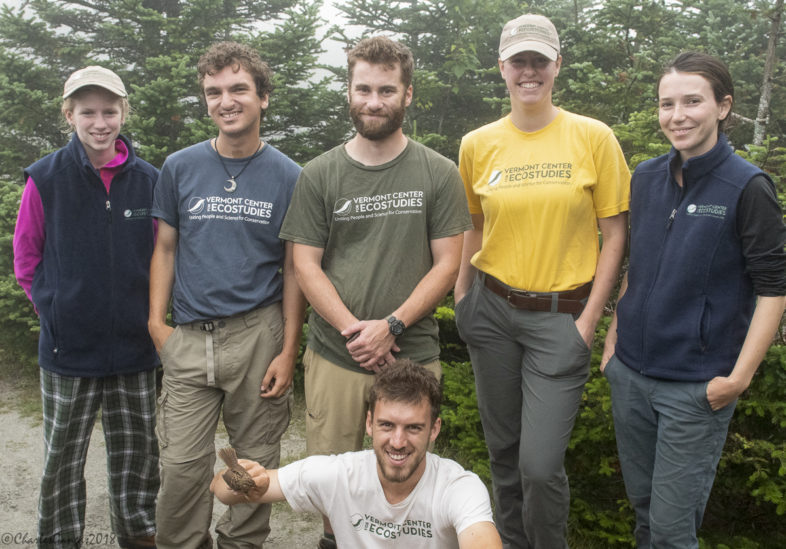
The VCE “hatch-year” field crew on Mansfield, 25 July 2018. From left: Brooke Hindinger, Alex Kulungian, Tim Duclos, Liza Morse, Tara Rodkey. Seated is Spencer Hardy with a banded juvenile Song Sparrow. Photo courtesy of Chuck Gangas.
What a difference a week can make. The VCE team returned to Mansfield on Tuesday-Wednesday this week, expecting far worse weather than we encountered, but also more birds. The forecast gale-force southerly winds were thankfully less than anticipated, alternating between periods of virtual calm and sustained gusts of 20-25 mph. Showers and thunderstorms never materialized, though clouds lowered on Tuesday night. As everywhere, it was very warm and extremely humid. I banded in shorts for the first time in years!
Despite conditions that were favorable, if not ideal, for mist netting, we had surprisingly few captures, ending up with only 17 birds total. Sights and sounds of avian activity were correspondingly low, with virtually no dusk or dawn chorus, and little evidence of family groups or free-roaming juveniles. No finches were seen or heard. Many adults were in early or mid-stages of flight feather molt, which may partly explain their lower capture rates (birds fly less when molting wings and tail), but the scarcity of immatures, both in and outside of our nets, was hard to explain. On roughly the same dates a year ago, we tallied 57 captures, of which >40 were young-of-the-year.
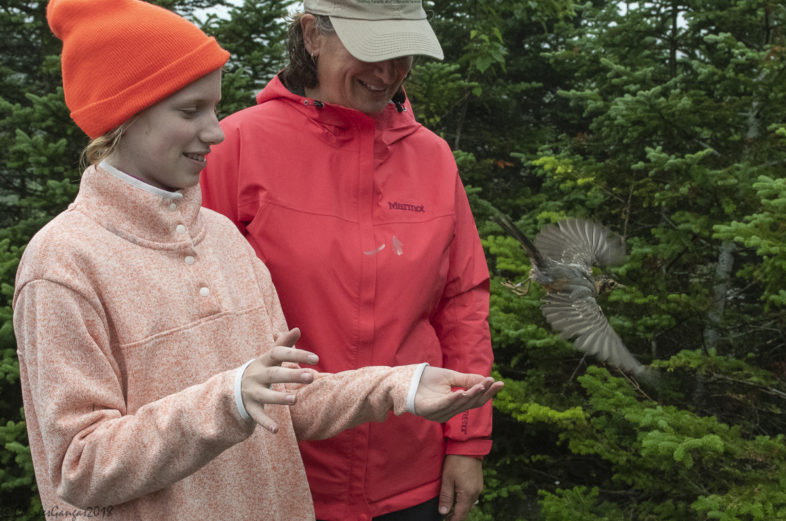
Brooke Hindinger (left) releases a banded juvenile American Robin as Mom (and VCE Associate Director) Susan looks on approvingly. Photo courtesy of Chuck Gangas.
Notables included overdue captures of the season’s first juvenile Bicknell’s Thrush and American Robin, as well as an out-of-habitat juvenile Song Sparrow.
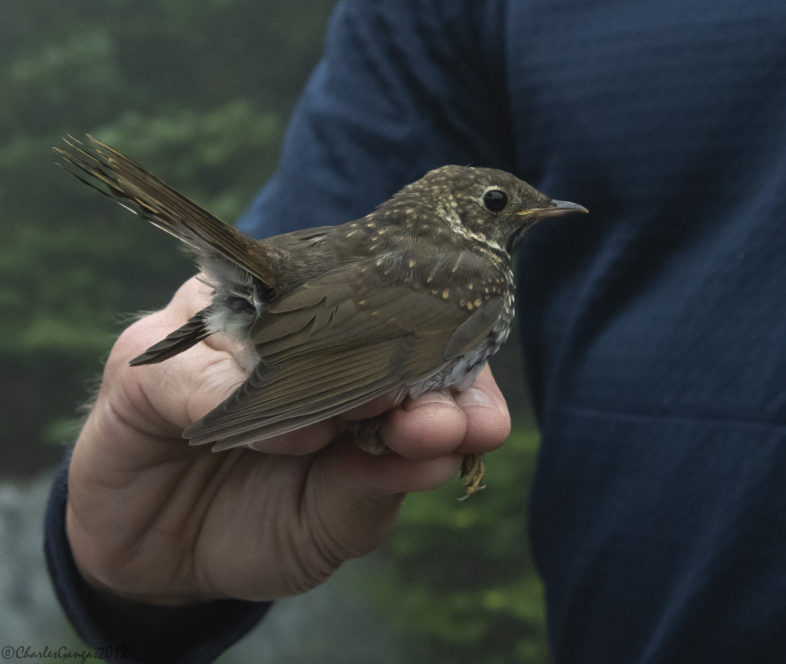
The season’s first juvenile Bicknell’s Thrush on Mt. Mansfield, 25 July 2018. Photo courtesy of Chuck Gangas.
Our capture totals:
Yellow-bellied Flycatcher — 1 female with refeathering brood patch
Red-breasted Nuthatch — 2 (free-flying juvenile and adult in heavy flight feather molt)
Bicknell’s Thrush — 2 (free-flying juvenile [FOY], within-season retrap female in early primary molt)
American Robin — 2 free-flying juveniles (FOY)
Blackpoll Warbler — 1 within-season retrap female in heavy flight feather molt
Yellow-rumped Warbler (Myrtle) — 4 (free-flying juvenile and 3 new males [2 in early molt])
Dark-eyed Junco (Slate-colored) — 2 free-flying juveniles
White-throated Sparrow — 2 (free-flying juvenile, new adult male in early primary molt)
Song Sparrow — 1 free-flying juvenile
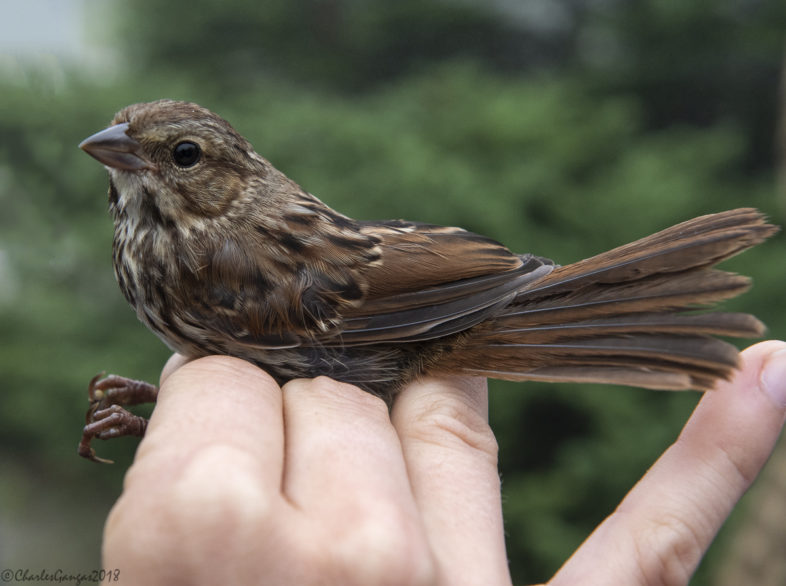
A misplaced juvenile Song Sparrow that turned up in VCE’s nets on Mt. Mansfield, 25 July 2018. Photo courtesy of Chuck Gangas.
I suspect this week’s low captures were due, at least in part, to weather, perhaps a combination of wind, humidity, and wet vegetation on Wed. morning. Next week’s visit will be our last of the summer, and I fully expect a very active session, with some northern hardwoods species and perhaps an early boreal migrant or two. Stay tuned.
A personal highlight and “first” for me: having my mother Clare and brother Dave visit our banding site. By all accounts, they thoroughly enjoyed the experience, both avian and human elements!
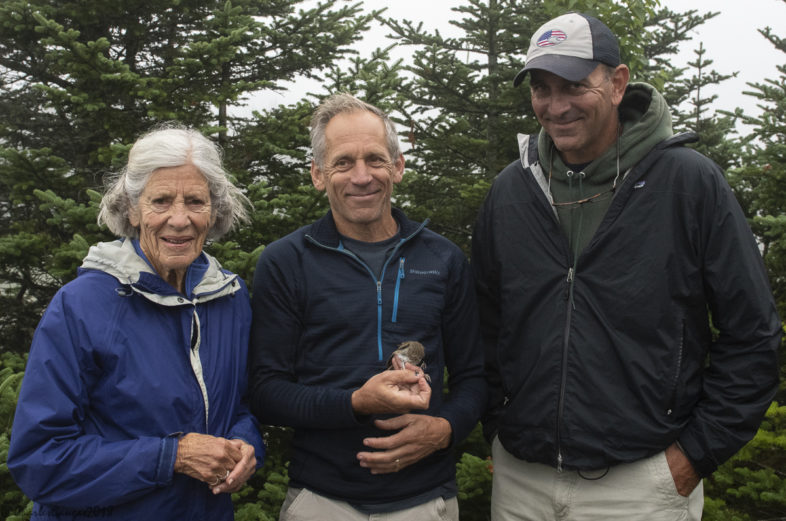
Rimmers invade Mansfield. From left: Clare, Chris (with banded Bicknell’s Thrush) and Dave. Photo courtesy of Chuck Gangas.

The fam😍
Love these posts😍